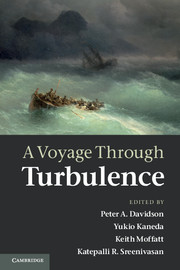Book contents
- Frontmatter
- Contents
- List of contributors
- Preface
- 1 Osborne Reynolds: a turbulent life
- 2 Prandtl and the Göttingen school
- 3 Theodore von Kármán
- 4 G.I. Taylor: the inspiration behind the Cambridge school
- 5 Lewis Fry Richardson
- 6 The Russian school
- 7 Stanley Corrsin
- 8 George Batchelor: the post-war renaissance of research in turbulence
- 9 A.A. Townsend
- 10 Robert H. Kraichnan
- 11 Satish Dhawan
- 12 Philip G. Saffman
- 13 Epilogue: a turbulence timeline
- References
5 - Lewis Fry Richardson
Published online by Cambridge University Press: 07 October 2011
- Frontmatter
- Contents
- List of contributors
- Preface
- 1 Osborne Reynolds: a turbulent life
- 2 Prandtl and the Göttingen school
- 3 Theodore von Kármán
- 4 G.I. Taylor: the inspiration behind the Cambridge school
- 5 Lewis Fry Richardson
- 6 The Russian school
- 7 Stanley Corrsin
- 8 George Batchelor: the post-war renaissance of research in turbulence
- 9 A.A. Townsend
- 10 Robert H. Kraichnan
- 11 Satish Dhawan
- 12 Philip G. Saffman
- 13 Epilogue: a turbulence timeline
- References
Summary
Introduction
The nature of turbulent flow has presented a challenge to scientists over many decades. Although the fundamental equations describing turbulent flows (the Navier–Stokes equations) are well established, it is fair to say that we do not yet have a comprehensive theory of turbulence. The difficulties are associated with the strong nonlinearity of these equations and the non-equilibrium properties characterizing the statistical behaviour of turbulent flow. Recently, as predicted by von Neumann 60 years ago, computer simulations of turbulent flows with high accuracy have become possible, leading to a new kind of experimentation that significantly increases our understanding of the problem. The largest numerical simulations nowadays use a discretized version of the Navier–Stokes equations with several billion variables producing many terabytes of information that may be analyzed by sophisticated statistical tools and computer visualization. None of these tools were available in the 1920s when some of the most fundamental concepts in turbulence theory were introduced through the work of Lewis Fry Richardson (1881–1953). Although his name is not as well-known as other contemporary eminent scientists (e.g. Einstein, Bohr, Fermi) and although his life was spent outside the mainstream of academia, his discoveries (e.g. the concept of fractal dimension) are now universally known and essential in understanding the physics of complex systems.
- Type
- Chapter
- Information
- A Voyage Through Turbulence , pp. 187 - 208Publisher: Cambridge University PressPrint publication year: 2011
References
- 1
- Cited by



